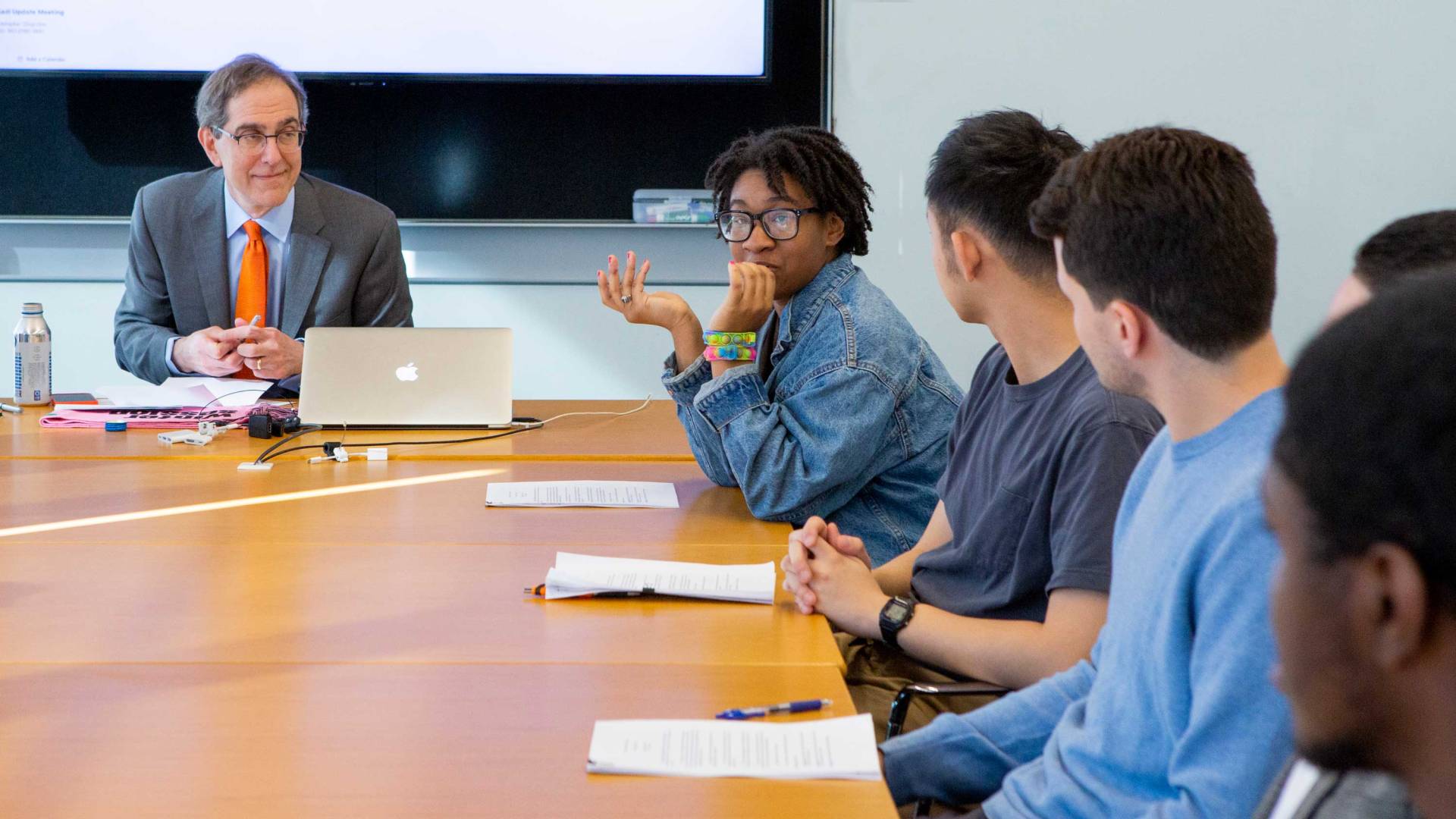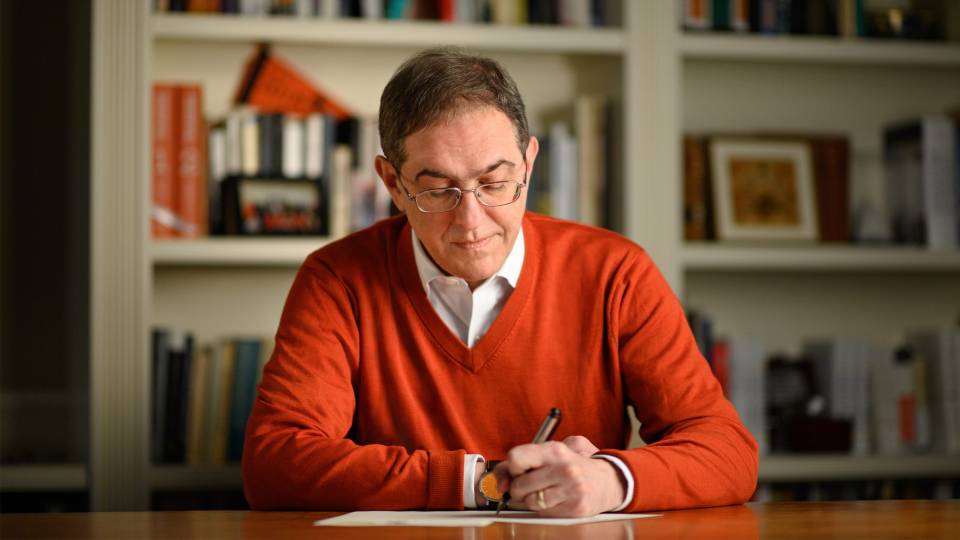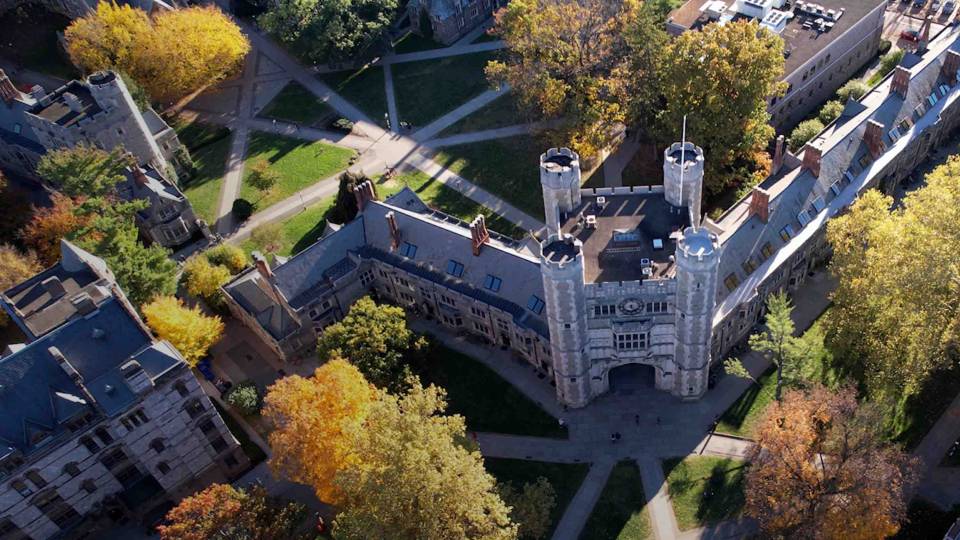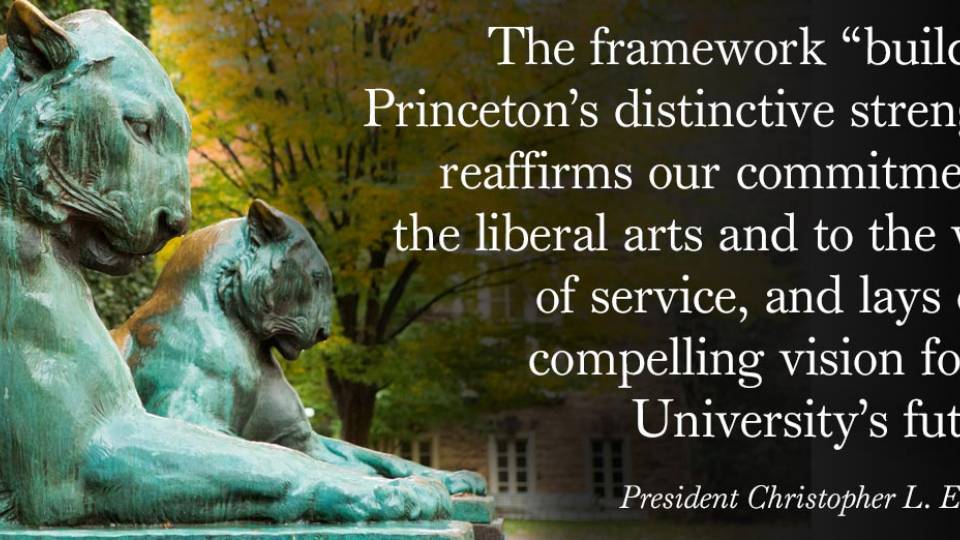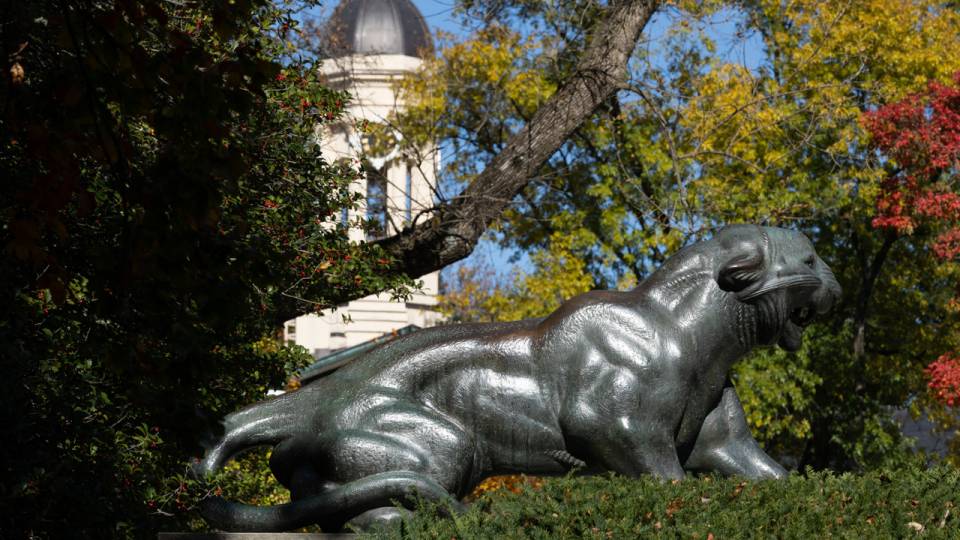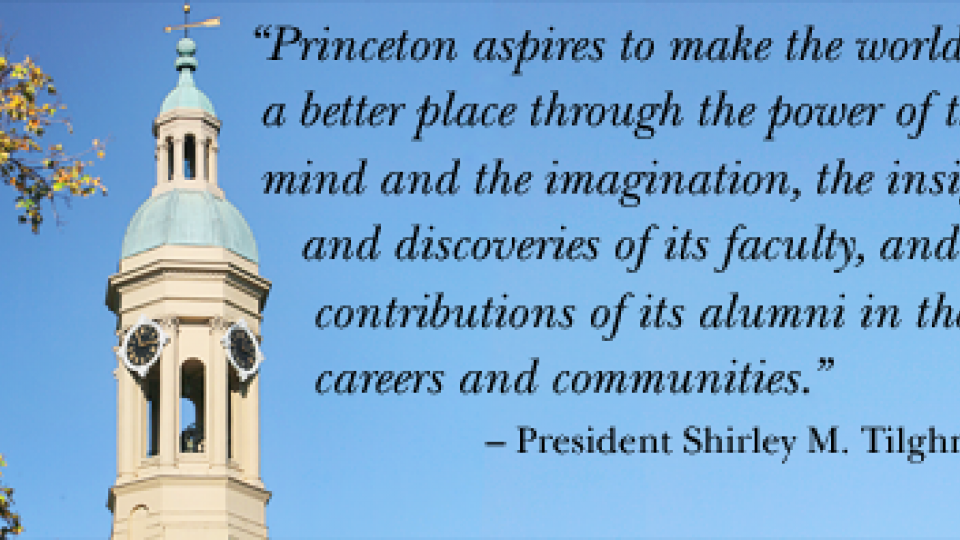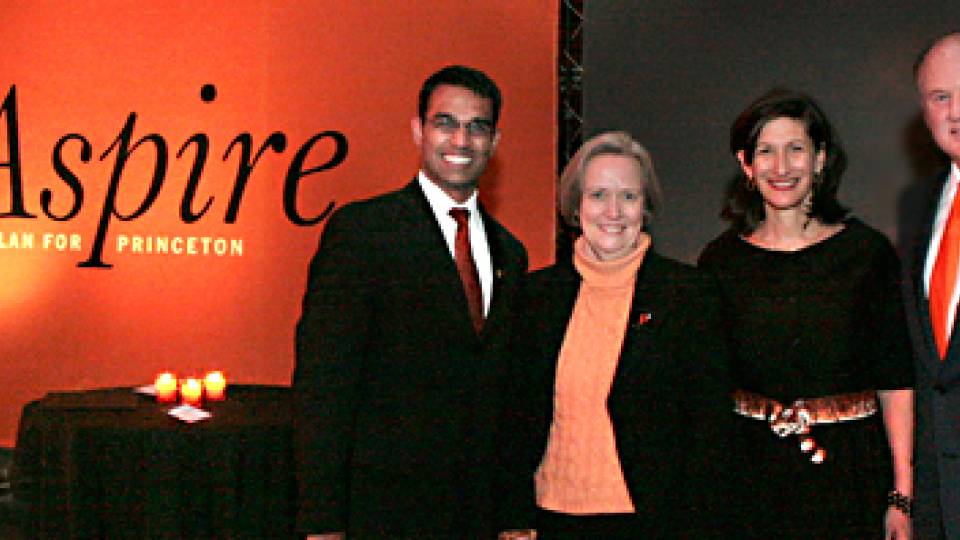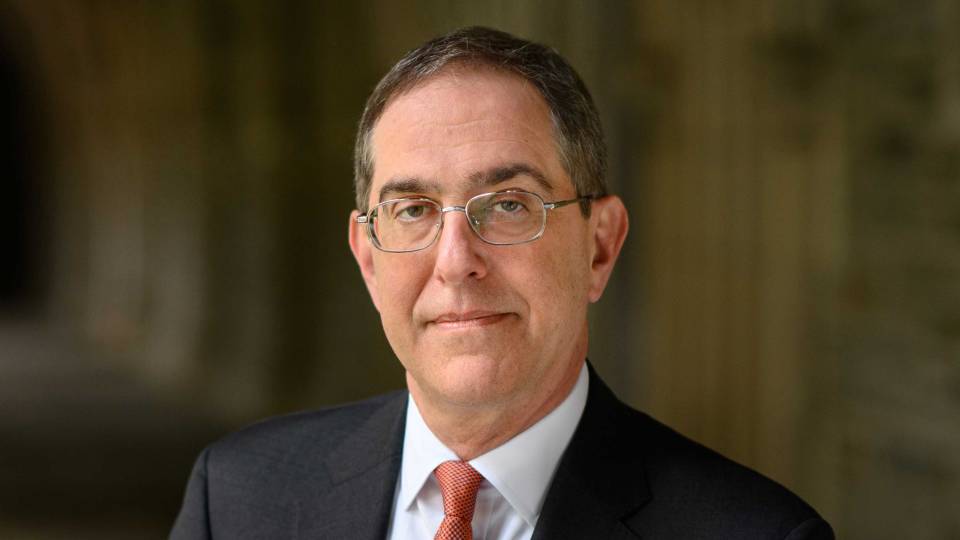Princeton University President Christopher L. Eisgruber leads a discussion with students about online media and civic discourse in a Wintersession workshop held Jan. 24.
Princeton University President Christopher L. Eisgruber sent his annual State of the University letter to faculty, students and staff on Tuesday, Jan. 31, celebrating Princeton’s full return to in-person teaching and research following COVID-19 and addressing how the University and other liberal arts institutions might adapt to the forthcoming challenges presented by rapidly developing technology.
Eisgruber wrote: “Computer science, data science, online media, and machine learning are rapidly changing how we read, write, learn, think, communicate, and socialize. They are affecting what students want to study, how research is conducted, and what topics scholars can explore. They are altering the world’s capacities and problems, and, with those, the issues that universities must address to prepare students for the future and deliver the research that our society needs.”
The letter reflects on what these changes mean for Princeton as a university committed to the ideals of liberal arts education, curiosity-driven research, and finding and supporting the best talent from all backgrounds.
To provide opportunities for community discussion of the topics in the letter, Eisgruber will discuss the letter and invite questions at two upcoming open meetings.
• All students, faculty and members of the broader University community are invited to join the upcoming meeting of the Council of the Princeton University Community (CPUC), which will take place 4:30 to 6 p.m. on Monday, Feb. 20, in the Frist Multipurpose Room. In the question and answer period for this meeting, priority will be given to council members and to student questioners.
• A Town Hall for University staff members will be held at 10 a.m. on Wednesday, Feb. 22, in Richardson Auditorium. The University will provide employees with paid release time so they can attend this meeting during normal work hours, subject to supervisory approval in order to maintain normal operations.
The State of the University letter is available as a pdf and is printed in its entirety below.
President’s Annual “State of the University” Letter 2023: The Liberal Arts University and the Challenges of Technology
Three years after the novel coronavirus appeared on the scene, Princeton’s residential, scholarly community is nearly, if not fully, restored to its pre-pandemic state. Our campus again pulses with vital energy, personal interaction, and creative inspiration.
Classes are meeting without the restrictions needed last year. Workshops, lectures, and colloquia are well attended. Crowds are welcome at performances, sporting events, and other gatherings.
Celebrations again take place in person rather than on virtual platforms, which is a good thing, because over the past 18 months Princeton has had a lot to celebrate. For example:
- Faculty and alumni have collected honors at a pace impressive even by Princeton’s high standards. In the 2021-22 academic year, for example, five Nobel laureates in the fall were later joined by a Fields medalist, an Abacus medalist, a Kyoto Prize winner, and a Schmidt Science Polymath, to name just a few. This fall, Ben Bernanke, a former faculty member and chair of the Department of Economics, received the Nobel Prize in Economic Sciences.
- Last year, Princeton made historic improvements to both its graduate fellowship program and its undergraduate financial aid program. In January 2022, Princeton increased graduate stipends for the 2022-23 academic year by an average of 25 percent, the largest such increment in the University’s history. In September, Princeton announced enhancements to its already best-in-class undergraduate financial aid program. Beginning next year, most students from households earning up to $100,000 will attend Princeton for free, and aid packages will improve across the income spectrum.
- Thanks to the outstanding work of our Advancement team and alumni volunteers, and to the generosity of our alumni and friends, Princeton opened the public phase of its Venture Forward campaign with one of the most successful years in history for fundraising and alumni engagement. Annual Giving set a new all-time dollar record ($81.8 million), and the University recorded the highest one-year fundraising total in Princeton’s history ($551.9 million). Venture Forward also ushered in a new digital tradition — Orange & Black Day, created by our spirited alumni — and in-person all-alumni gatherings in New York City, San Francisco, and London.
- In December, the Princeton University Art Museum announced a historic gift from Preston Haskell III ’60 that includes eight abstract masterpieces from his private collection. These stunning paintings will take the Museum’s collection of modern art to a new level of excellence.
- Our students distinguished themselves both academically and in extracurricular pursuits. Already this academic year they have been awarded a Rhodes Scholarship, a Marshall Scholarship, and five Schwarzman Scholarships, and our athletic teams have captured another four league titles after winning sixteen last year.
- Reunions, held in person for the first time in three years, were a joyous affair. They were among the highlights of a festive week that included two Commencement ceremonies (for the Classes of 2020 and 2022), three 50th Reunion dinners, three 25th Reunion dinners, and more than 25,000 people. Our staff did a fabulous job hosting the many people and events despite the lingering effects of the pandemic and unseasonably high temperatures.
- Our Facilities team and their partners in numerous campus departments and offices pushed ahead with the most ambitious building program in the University’s history despite the pandemic’s disruption to work schedules, labor markets, and the supply chain. Their outstanding work enabled Yeh College and New College West to open this fall as anticipated.
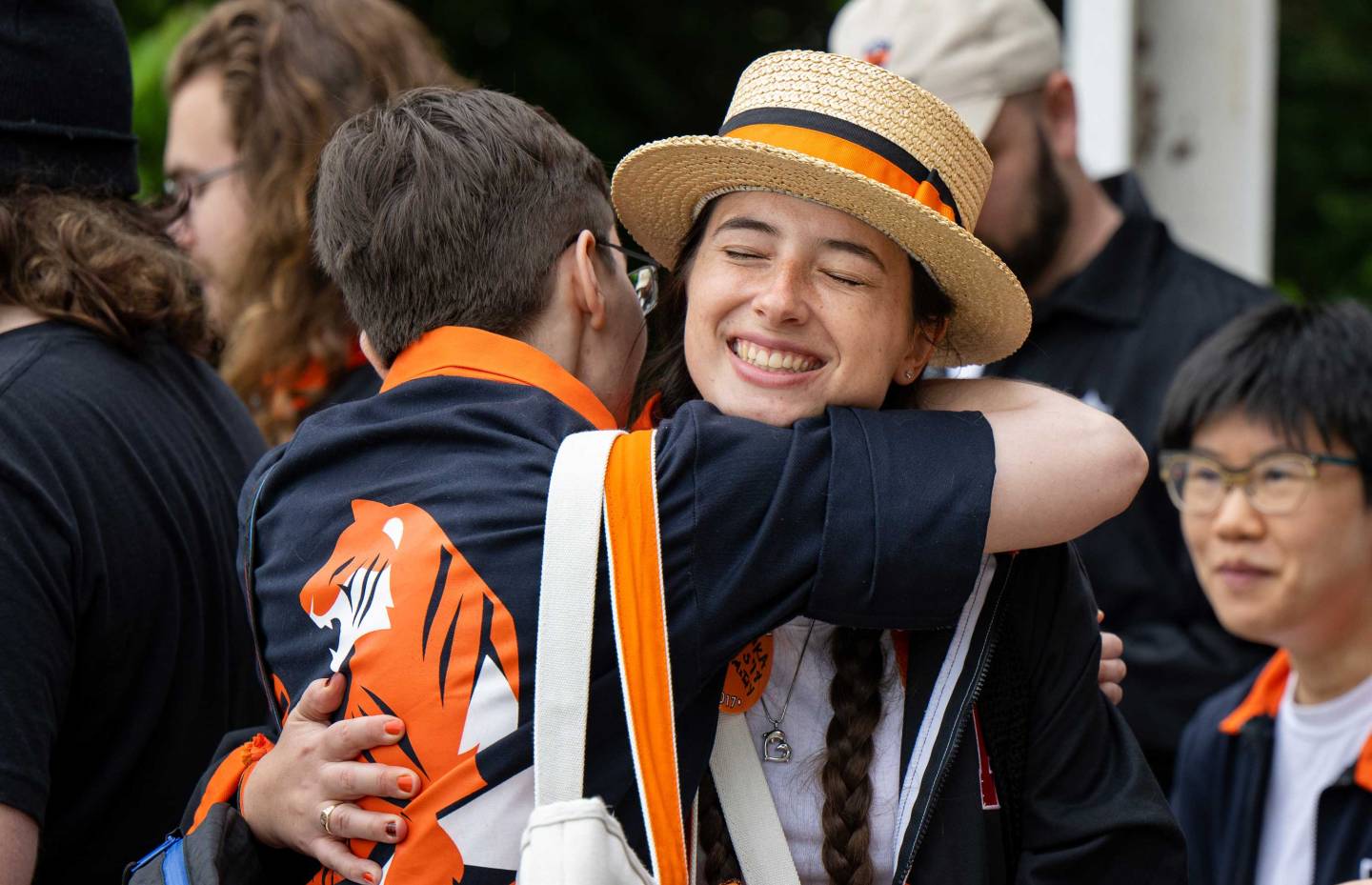
Held in person for the first time in three years, Reunions 2022 were even more joyous and celebratory. More than 25,000 alumni and their guests returned to campus.
The pandemic, to be sure, persists; as I write this letter, COVID-related deaths in the United States still average more than 500 per day. We cannot know what variants might lie ahead. We will need to be ready to adapt if necessary.
Still, as we enter 2023, we can enjoy more of the activities that we cherish and that define the mission of this University. And, because our planning capacity is no longer so occupied by short-term questions about the public health crisis, we can once again devote more time and attention to fundamental questions about the University’s values and future.
Among the most profound of those questions is how Princeton and other liberal arts research universities should adapt to the challenges of rapidly evolving technology, including information technology and artificial intelligence.
Computer science, data science, online media, and machine learning are rapidly changing how we read, write, learn, think, communicate, and socialize. They are affecting what students want to study, how research is conducted, and what topics scholars can explore. They are altering the world’s capacities and problems, and, with those, the issues that universities must address to prepare students for the future and deliver the research that our society needs.
I will devote most of this year’s letter to some reflections on what these changes mean for Princeton as a university steadfastly committed to the ideals of liberal arts education and curiosity-driven research. I will connect those reflections to the University’s strategic framework and to the set of initiatives underway on campus. I will conclude with some added thoughts about our continuing efforts to ensure that talent from all backgrounds and sectors of society can flourish at this University and benefit from its teaching and research.
The Strategic Framework’s Key Judgments
Questions about technology’s implications for Princeton’s mission may be increasingly vivid and urgent, but they are not new. They were crucial to the University’s multi-year, campus-wide planning process that produced its strategic framework in 2016.
The strategic framework was created with the hope that its principles would guide the University over many years and the expectation that it would be updated or revised regularly to address changing needs and opportunities.
The framework has served its purpose well. The University’s trustees enthusiastically reaffirmed and updated the framework in 2019. They will review it again this year as part of the periodic planning cycle envisioned by the 2016 report.
The priorities identified in the strategic framework rest on four key judgments:
- Princeton University’s distinctive and long-standing mission — as a residential research university committed to an expansive vision of the liberal arts that encompasses engineering — is robust, valuable, and important to the world.
- Princeton’s exceptional capacity for teaching and research carries with it special responsibilities to expand the range of people who benefit from that opportunity, to strive for the highest levels of quality in research and education, and to address the challenges of the 21st century.
- Technology is rapidly reshaping research, pedagogy, and society, with substantial consequences for the University’s mission.
- The University can and should raise its endowment spend rate so that it can co-invest with alumni and friends to support initiatives that will enhance Princeton’s impact on the world today and for generations to come.
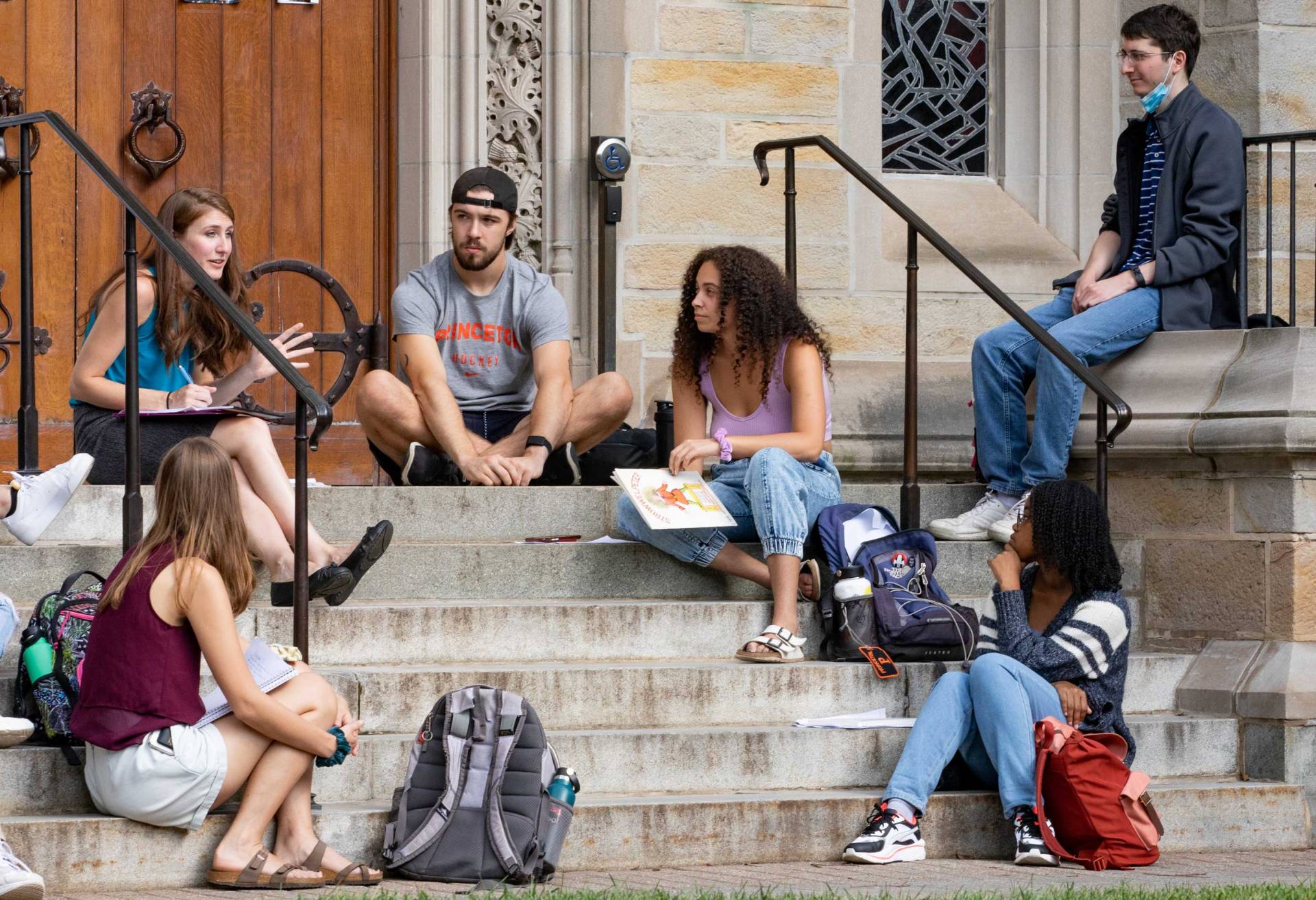
The power of Princeton’s residential, in-person model was affirmed in the University’s 2016 strategic framework and seems even more compelling in the wake of the COVID-19 pandemic.
The framework offers multiple justifications for embracing Princeton’s model of residential, liberal arts education. It emphasizes that a Princeton degree fares exceptionally well even if judged only the basis of its economic value or other utilitarian metrics.
The framework then recognizes that a Princeton education must also serve loftier goals. A Princeton education “should shape the whole person,” and “the University’s research should enhance not only the productivity but also the quality and humanity of our nation and our world.”
The framework adds these observations:
“At a time when the world often focuses on short-term issues and seeks immediate solutions, Princeton enables scholars and students to pursue long-term goals. It brings talented individuals together for interactions both deliberate and serendipitous, and it gives those individuals the freedom and the support they need to pursue a dazzling range of questions and projects. Princeton thereby catalyzes learning, creativity, innovation, and collaboration. The benefits of this activity may take years or even decades to blossom fully; they can help society to address not only the problems we know today, but also future concerns that we cannot yet identify or even imagine.”
The University’s trustees issued this endorsement of residential learning in 2016, at a time of growing interest in online education. The power of the residential, in-person model seems even more compelling in the wake of the pandemic, which required Princeton and other universities to use online teaching in unprecedented ways.
When colleges initially moved their courses online in March 2020, some people predicted that this forced experiment with remote learning would demonstrate the inefficiency of residential teaching models. It instead highlighted how difficult it is to teach online effectively, especially at undergraduate and pre-collegiate levels. There is now widespread concern about “learning loss” from the deficiencies of online education, a problem that affects even the exceptionally talented students who apply to and attend Princeton.
To be sure, the experience of online teaching during the pandemic broadened familiarity with what could be done online. The knowledge may enable Princeton to leverage technology to improve the residential education it offers or to expand the impact of its teaching to new audiences. If so, however, we will have to do so in a way that respects the power of residential engagement and the limits of online teaching, which is one reason why Princeton required beginning in fall 2021 that all classes once again meet in person.
Yet, even while in-person engagement remains essential to education, the success of Zoom and other platforms demonstrated yet again how quickly and pervasively technology can change our lives. In recent weeks, ChatGPT has provided another window into how powerful — and how disruptive — artificial intelligence can be.
That is why any great liberal arts university in the 21st century must wholeheartedly embrace the study of technology. Critical thinking skills are at the heart of a liberal arts education, and in today’s world those skills must encompass the ability to understand, develop, and use technology both effectively and ethically.
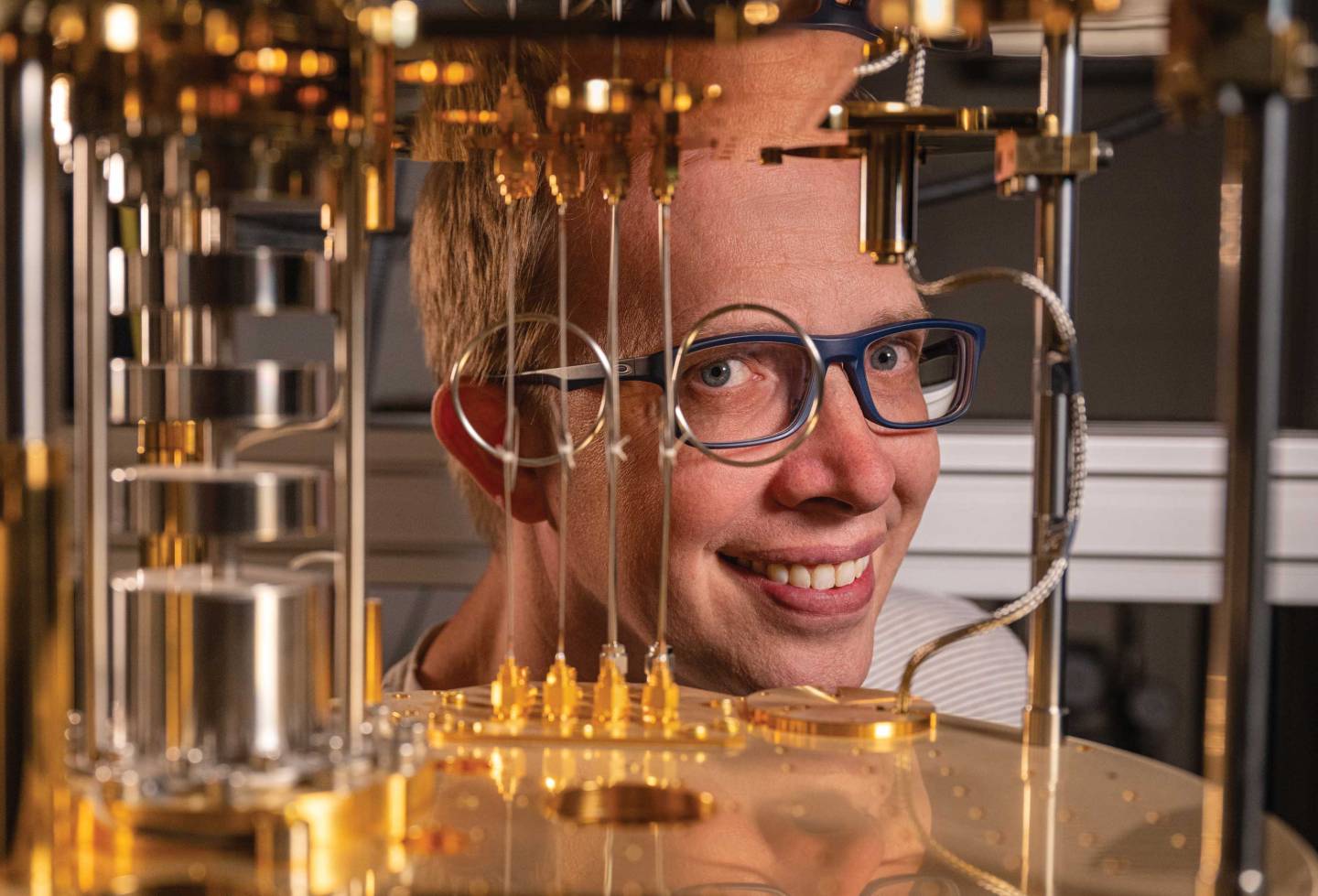
Andrew Houck, professor of electrical and computer engineering, is among the distinguished researchers at Princeton who are making advances in quantum computing and quantum science. Houck has focused much of his work on designing systems that eliminate, reduce or are indifferent to error-causing noise.
Strengthening Princeton’s School of Engineering and Applied Science
While the challenges of technology will demand attention from scholars throughout the University, the strategic framework recognized that the School of Engineering and Applied Science will be pivotal to Princeton’s response:
“Princeton’s outstanding School of Engineering and Applied Science, which uniquely blends the qualities of a great engineering school and Princeton’s commitment to the liberal arts, gives the University a special advantage in addressing technological change and its consequences for society. Princeton embraced engineering during a period when some Ivy League universities ignored the field. Princeton thereby made a wise choice: it has become clear that in the 21st century, a great liberal arts university requires a great engineering school.”
Interest in engineering at Princeton has exploded over the past decade. Engineering majors now account for 28 percent of the University's undergraduate students, up from around 19 percent in 2012-13.
The computer science department teaches more students and attracts more majors than any other department in the University. Its growth over the past two decades has been astonishing. For example, concentrators have grown from around 36 students in the class of 2011 to more than 200 in this year’s junior class; total course enrollments during that period have more than doubled, from 1,738 in 2010-11 to 4,152 this year.
Part of the appeal of these disciplines undoubtedly comes from the market value of their degrees, but they also offer intellectual depth and societal benefit. Technical and scientific advances have, for example, given engineers the capacity to model and control microscopic biological processes, manipulate exotic quantum phenomena, and design therapeutic interventions to address healthcare problems and environmental harms.
And, conversely, computational advances and new technologies are empowering scholars across the disciplines to ask and answer novel questions about the human brain, economic behavior, ecological systems, the evolution of literary practices, and galactic structures, to name only a few. We are already seeing a new generation of researchers who combine disciplinary expertise in departments across the University with fluency in computational and statistical techniques.
Because our School of Engineering and Applied Science is integrated into the liberal arts ethos of the University, we can educate engineers who create and apply technology deeply informed by the insights and values drawn from the arts, humanities, and social and natural sciences. And because all of our students are encouraged to take courses in the engineering school, we can educate leaders in other fields who are competent and comfortable with technological issues.
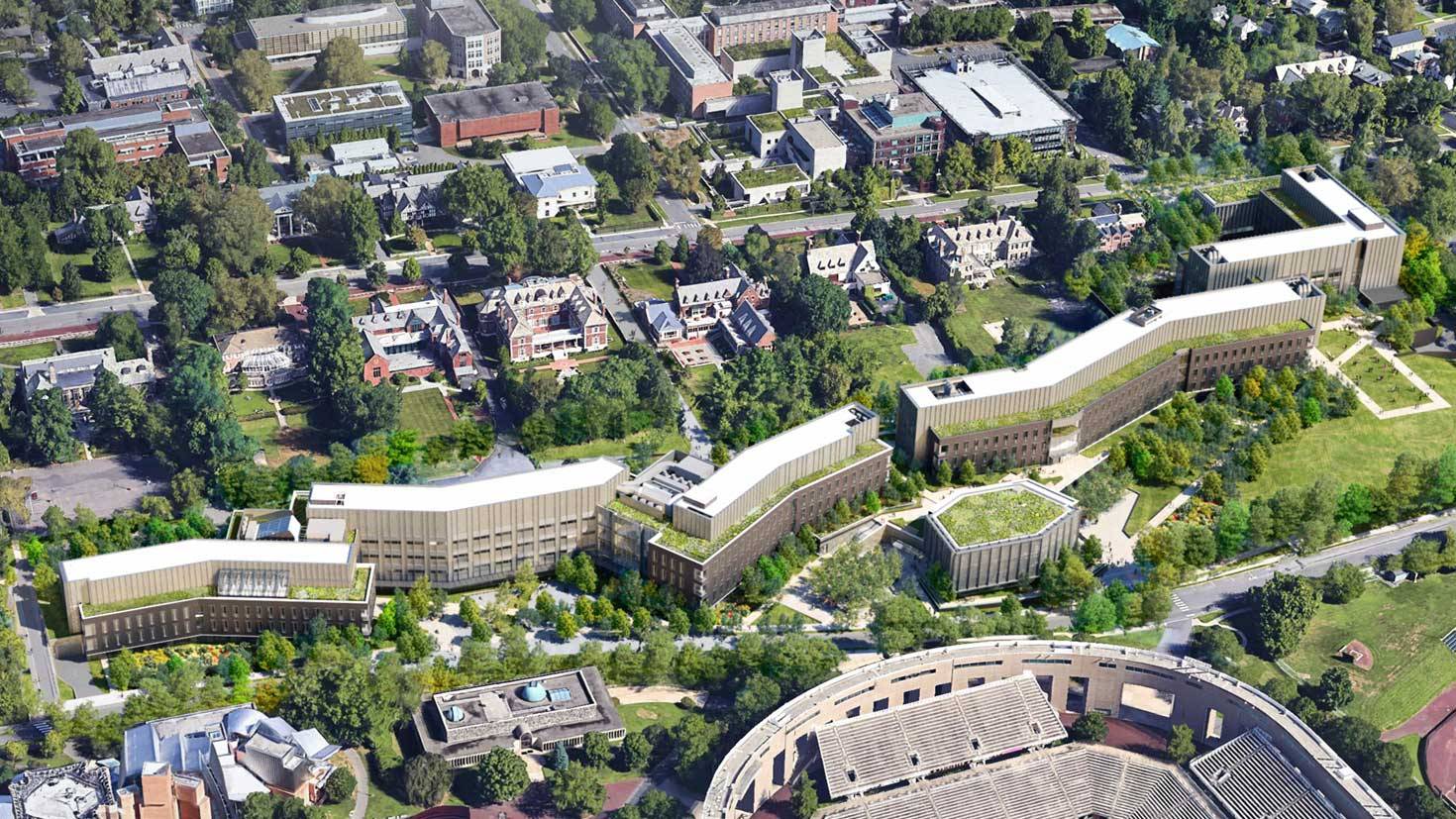
Princeton is investing boldly in Environmental Studies and the School of Engineering and Applied Science (ES+SEAS). The new ES+SEAS neighborhood under construction includes a “necklace” of connected buildings expanding the University’s facilities for engineering and environmental science.
To continue this momentum, seize the opportunity to innovate, and respond to the challenges of technological change, Princeton is investing boldly in its School of Engineering and Applied Science. People are the heart of that initiative, but to attract and retain outstanding faculty, students, and staff, we need facilities that enable them to thrive and achieve the highest levels of excellence.
The strategic framework recognized that while “Princeton is fortunate to have a superb engineering faculty,” its professors and students do much of their work in outdated “facilities constructed to a utilitarian standard more than a half-century ago.” That is why we have undertaken the massive building project that begins at the current Guyot Hall and runs most of the length of Western Way.
After renovation, Guyot Hall will become Eric and Wendy Schmidt Hall, the new home for the Department of Computer Science. A connected series of buildings on the north side of Western Way will house the environmental sciences, Princeton’s new bioengineering institute, the Department of Chemical and Biological Engineering, and an engineering commons.
In the years ahead, the new ES + SEAS neighborhood will also become the home for other departments now located in the old EQuad. The new location will bring SEAS from the periphery into the core of the University, thereby facilitating stronger links between its departments and those in the humanities, natural sciences, and social sciences.
Online Media, Civic Culture, and the University
Such interdisciplinary connections will be essential if the University is to meet the challenges of this moment. Many of the most urgent and profound questions arising out of technological change are not themselves technical but cultural, psychological, ethical, and political.
The University’s 2016 strategic framework mentioned in passing that technology was changing not only teaching, research, innovation, and professional opportunities, but also the “organization of human society” and how people “connect with one another.” That sentence is probably the most striking understatement in the document.
Even as recently as 2016, when Princeton issued its strategic framework, it was hard to grasp the profound and pervasive effects that online media were already having on individuals and communities.
In 2016, the iPhone was not yet 10 years old. Princeton had yet to graduate a class of students who had used or seen a smartphone while in grade school. Now few of us can imagine a world without them. Indeed, most of our students have never known such a world.
We are only just beginning to understand the nature and magnitude of the changes being wrought to our minds and our societies. Some of those changes are positive. I do not know how we would have persevered during the pandemic, for example, without the means to teach and work online. Information that might in the past have required trips to faraway archives or libraries is now at our fingertips. We can stay in touch with distant friends, find new ones, and renew lost acquaintanceships. The list goes on.
There are also, however, dark sides to this new world. Nearly everyone now spends large amounts of time online. In general, the apps and media in this virtual world become more profitable if users spend more time on them. For that reason, they are typically designed to attract and keep our attention.
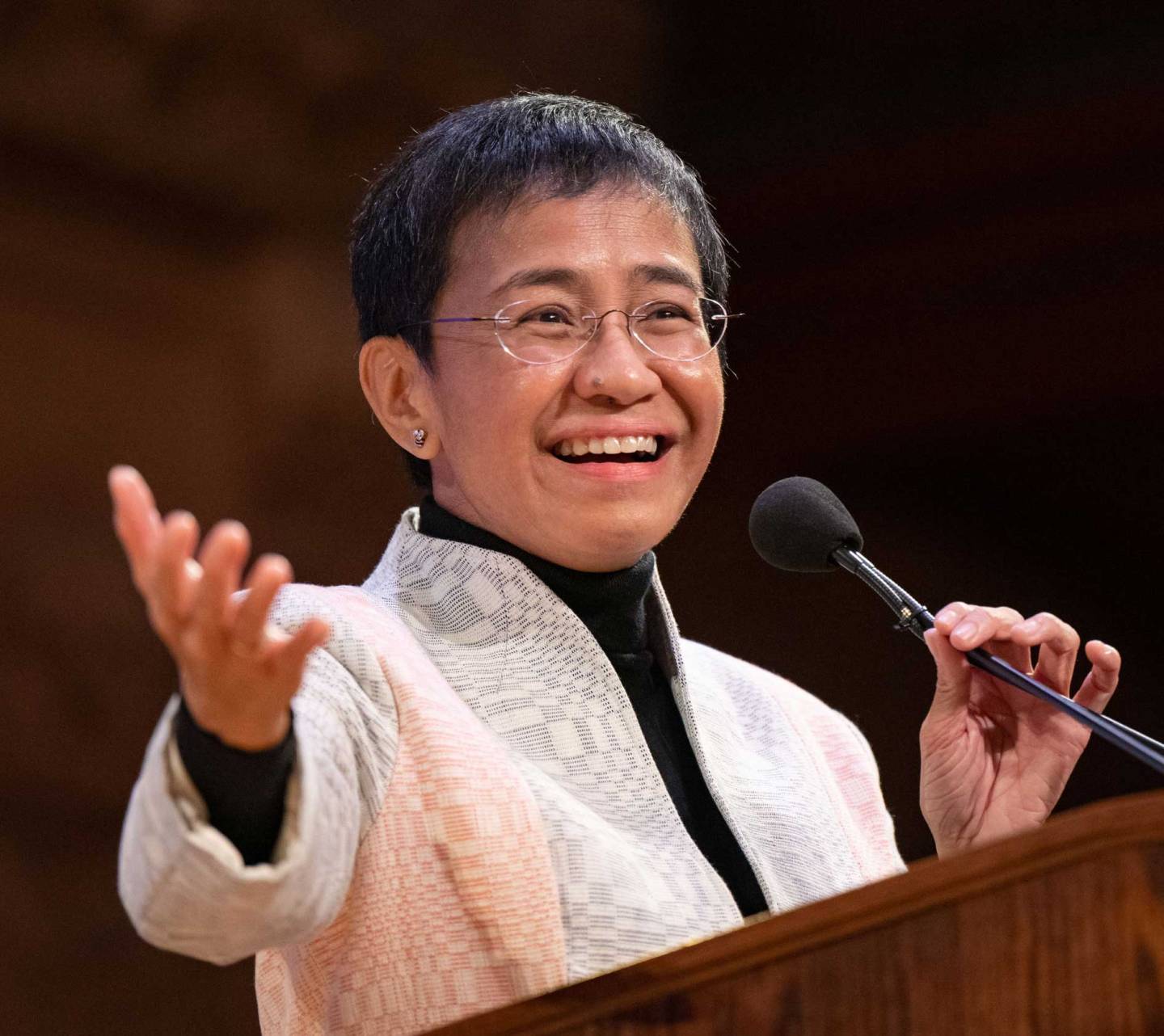
At Princeton’s Alumni Day in 2022, Nobel Laureate Maria Ressa, Class of 1986, discussed how social media and other digital platforms make it much harder for the public to discern what is true.
The new communications environment privileges information not because it is true or edifying but because it is attention-getting. For most if not all human beings, what rivets attention is the provocative, the extreme, the diverting, the divisive, or the visually arresting.
These distractions are not only powerful but omnipresent. We carry the world, and our worries, in our pockets. We are tempted by our phones, and the tantalizing array of stimuli they hold, everywhere, including in spaces — such as libraries, theaters, parks, and restaurants — that once provided havens for study, reflection, and human camaraderie.
Like New York University’s Dr. Jonathan Haidt and Nobel Laureate Maria Ressa ’86,[1] I believe that this communications environment poses a fundamental challenge to our civic life and to truth-seeking institutions, including colleges and universities.
The challenges include but go beyond concerns about “disinformation” or other specific content on the internet. Even when the information they provide is fully accurate, online media facilitate distraction, remoteness, and provocation.
Education and research, by contrast, depend upon concentration, engagement, and civil exchange. The tension between the online world and the scholarly world is thus real and deep: we live in a world flooded with the intellectual equivalent of irresistible junk food, and getting people to “think healthy” is harder than ever.
Scholars are beginning to produce the insights and recommendations that we need to comprehend and address these changes. Some of them have argued that online activity is a major contributor to the epidemic of mental illness confronting our nation and its young people.[2]
These claims are controversial,[3] but it seems undeniable that the students who arrive at Princeton today have grown up very differently from even their quite recent predecessors. The relevant question is not whether those differences have changed the way that students learn and live, but rather how they have done so.
Answering that question, and others about how technology is changing individuals and society, will be a major challenge for Princeton and other colleges and universities in the years ahead. I hope and expect that our faculty, students, and staff will bring forward new initiatives so that this University can address these issues through its research and in its own campus community and pedagogical culture.
Building a Liberal Arts University for the 21st Century
The magnitude and character of these challenges reinforce the 2016 strategic framework’s conclusion that despite — and, indeed, because of — the many changes wrought by technology and other social forces, this University’s “distinctive model and mission are today more vibrant, valuable, and relevant to the world’s problems than ever.”
The framework called for a collection of initiatives by which Princeton University would both “address technology’s impact” and extend “the principles that define it as a liberal arts university into the 21st century.”
The priorities that emerged from the framework, and the larger strategic planning process that accompanied it, are manifest in our investments in the School of Engineering and Applied Science along with numerous other projects and initiatives that touch every sector of the campus.
Their goal is to reinforce the excellence of the University’s core teaching and research enterprise across multiple fields; reach more students from more backgrounds; add to the University’s capacity in engineering, computer science, and related fields; open the University up to a wider range of collaborations with both academic and non-academic partners; and enhance Princeton’s commitment to service.
Here are a few examples:
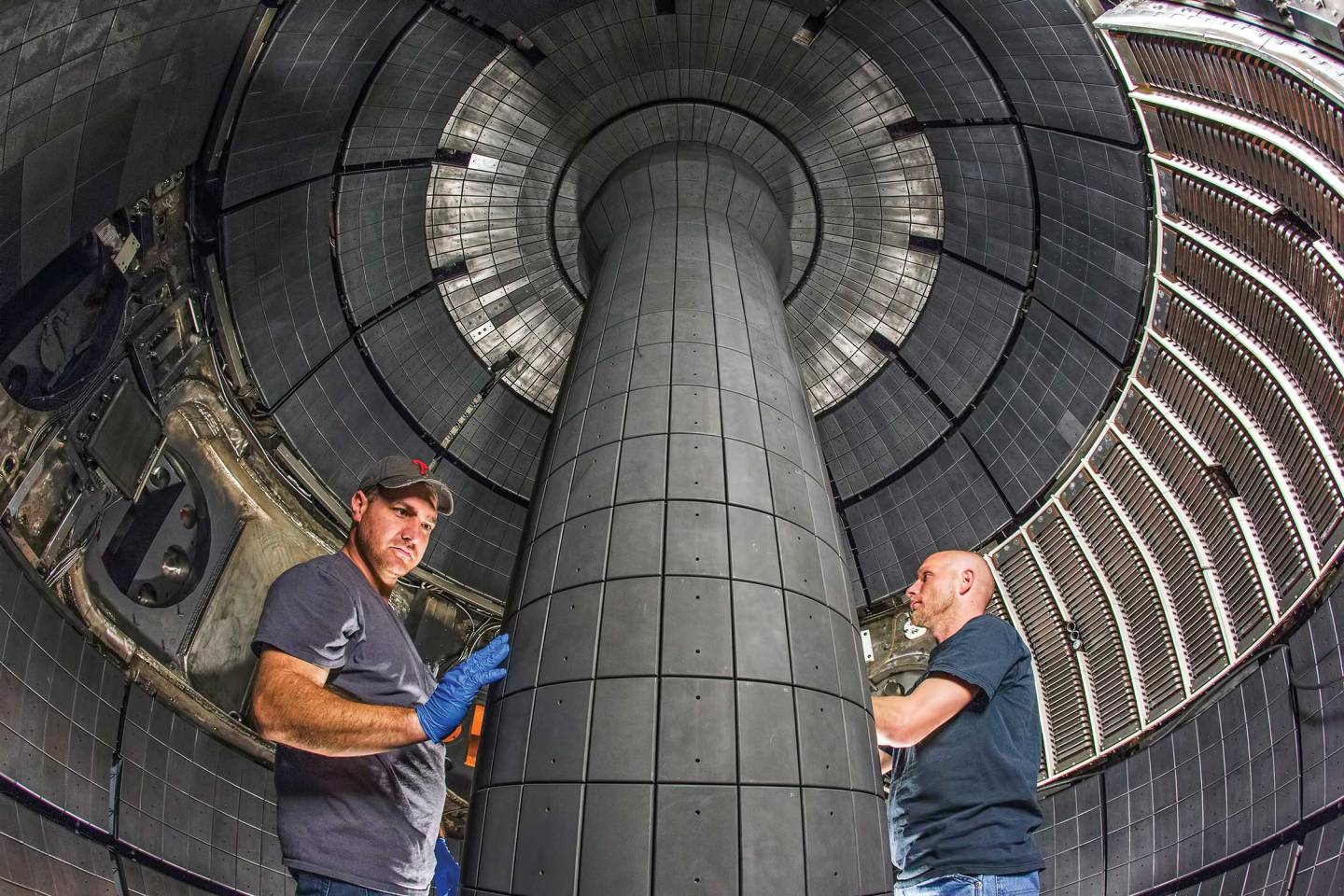
To ensure that the University’s teaching and research address urgent national and global issues, Princeton has built or strengthened initiatives in key areas, including fusion energy research at the Princeton Plasma Physics Laboratory, the Department of Energy national fusion lab managed by Princeton.
- To reach more students, we have not only added two residential colleges but also are creating a new health center and new recreational facilities to support the increase in the undergraduate population.
- To reach and support students from more backgrounds, we increased the socioeconomic diversity of our undergraduate and graduate student bodies. We also created a new transfer program focused on military veterans and community college students, and over the last year we announced historic increases to both undergraduate scholarships and graduate stipends. Our efforts have attracted favorable attention from the New York Times, Washington Post, Wall Street Journal, and 60 Minutes.
- To ensure that talented individuals from all backgrounds flourish on our campus, we have reaffirmed and expanded upon our commitment to racial equity. Though we have much more work to do, progress is manifest in, among other things, improvements to the diversity of our graduate student body, faculty, administrative leadership, and roster of professional consultants, contractors, and vendors.
- To invest in academic excellence more broadly and to ensure that the University’s teaching and research address urgent national and global issues, we have built or strengthened initiatives in environmental science and policy, American studies, regional studies, and plasma physics, among other fields.
- To reinforce the University’s strengths in multiple liberal arts disciplines, we are constructing a new Art Museum that will enhance the power and accessibility of the University’s collection and serve as a central gathering point for humanists on campus.
- To add new graduate housing, state-of-the-art athletics facilities, and new sites for future research laboratories and collaborative ventures, we are creating the Lake Campus development on the south side of Lake Carnegie.
- To promote the well-being of our community, leaders from the University’s campus life team, health services, the undergraduate and graduate student governments, and other units are cooperating to enhance mental health resources and support available to students, staff, and faculty.
- To catalyze innovation and open the University to a broader range of partnerships with non-academic partners, we have expanded programs on entrepreneurship, revised University policies, and established the Office of the Vice Dean for Innovation. Early successes include the launch of a joint Google-Princeton AI lab across Nassau Street and the formation of a Princeton-led Innovation Corps Northeast Hub sponsored by the National Science Foundation.
- To encourage students to incorporate service into their lives at Princeton and after graduation, we have increased both the number of service opportunities and their connection to the academic curriculum. In October, we announced a new program, LENS (Learning and Education through Service), that promises at least one funded service opportunity for every Princeton undergraduate.
These initiatives have required what is perhaps the most ambitious capital construction program in Princeton’s history. Mindful of the University’s environmental responsibility, we have designed and supplemented those projects to make the campus carbon-neutral on or before the University’s tricentennial in 2046.
I recognize that the number and scale of these projects make them disruptive for all of us. Living amidst construction is not easy, and I appreciate the changes people have made to adapt to it.
The short-term impositions will eventually give way to long-term enhancements. Like the past projects that benefit us today, those underway now will help Princeton to respond to the challenges of this century, create opportunity for new generations of students and faculty, deepen our commitment to teaching and scholarship of the highest caliber, and add to the beautiful and inspiring spaces that make this campus so special.
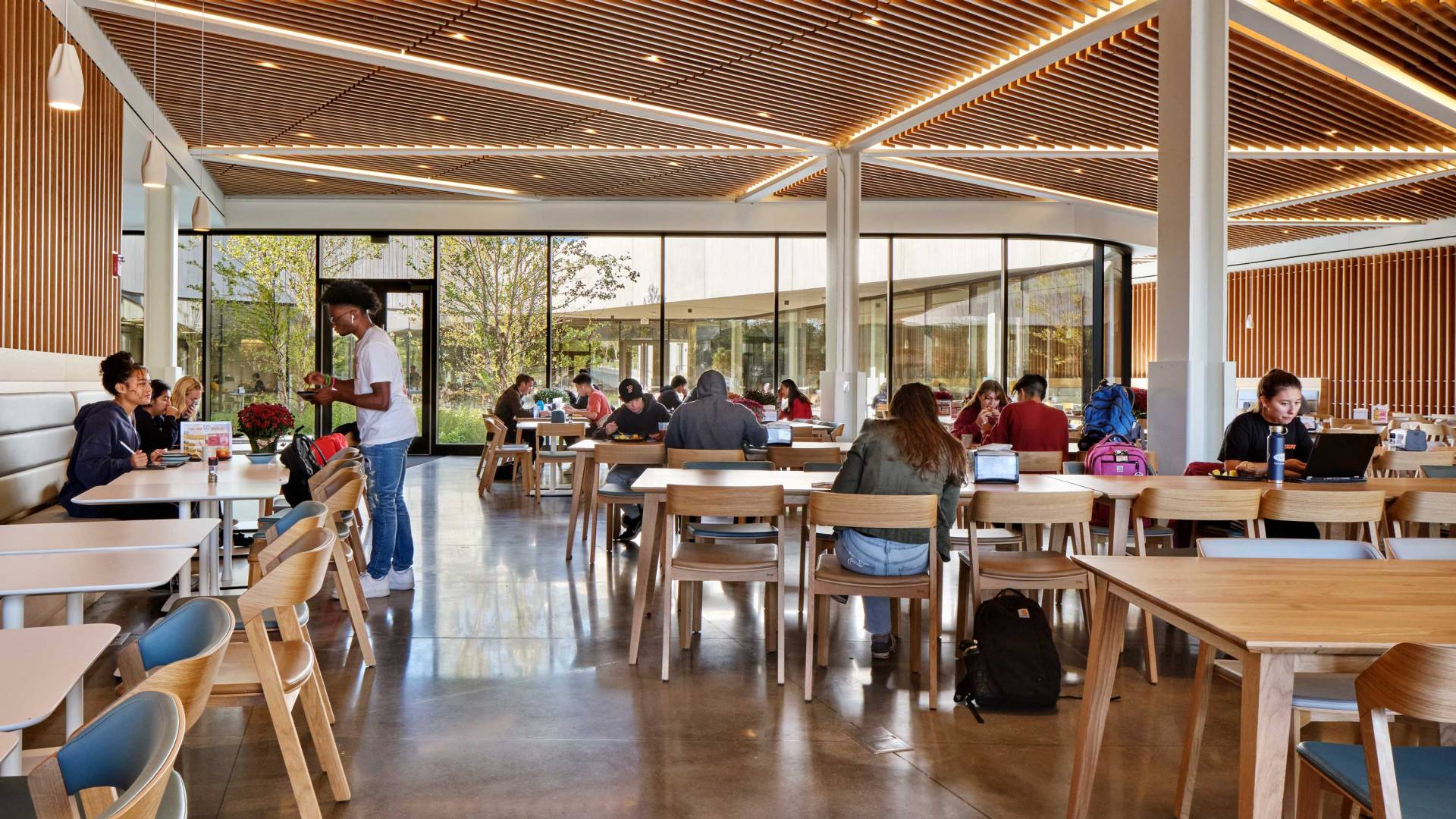
The opening of Yeh College (pictured) and New College West have enabled Princeton to share its unique liberal arts model with the largest entering class of students in the University’s history.
Reaching More Students from More Backgrounds
One of my highest priorities since taking office has been to make a Princeton education accessible to more students from more backgrounds. As the strategic framework rightly emphasizes, the education that we offer is more important today than it has ever been; if we can share it more widely, we should.
I am therefore delighted that one of our largest construction projects is now complete and benefiting the campus community. The opening of Yeh College and New College West has enabled us to share Princeton’s unique liberal arts model with the largest entering class of students in the University’s history.
The new residential colleges are important for many reasons. Most fundamentally, the new colleges permit Dean of Admission and Financial Aid Karen Richardson to say “yes” to more of the spectacularly talented young people who apply to the University each year. Dean Richardson tells me that roughly 18,000 applicants each year are as well qualified as the students whom we admit.
If we can take more of those students without diminishing the essential qualities of a Princeton education, we should: A Princeton education is transformative for the students who receive it, and the additional students whom we accept will contribute positively both to our campus and the world beyond it.
The new colleges enhance the residential life of our campus in numerous ways, including through amenities such as a demonstration kitchen, a ceramics studio, and an indoor/outdoor performance space. The colleges' architecture embodies a commitment to transparency and inviting common spaces designed to make it easier for students to enjoy one another’s camaraderie and company.
Gender-neutral restroom facilities in the new colleges reflect the University’s commitment to enable students of all gender identities to thrive on this campus. That commitment is especially important at a time when LGBTQIA+ individuals face increasing levels of discrimination and hostility in many sectors of society.
By creating new admission slots, the colleges also help Princeton to continue its efforts to attract and support students from all backgrounds. I have made it a priority throughout my presidency to increase the socioeconomic diversity of Princeton’s student body, and I have described our progress in past letters.
That work continues. Our transfer program, which focuses on military veterans and community college students, doubled in size with this year’s entering class. Though the program remains small — the enlarged transfer class consists of 25 students — I expect that it will continue to grow in the years ahead.
As noted already, over the past year we made historic improvements to our already best-in-class undergraduate financial aid program and to graduate fellowship stipends. We expect that these changes to undergraduate and graduate aid will enable more low-income and middle-income students to thrive at Princeton, and that their magnitude and impact will surpass even the unprecedented 2001 reforms that replaced loans with scholarships and thereby eliminated the need for Princeton students to take on debt.
Princeton’s commitment to socioeconomic diversity extends beyond its own campus. Through the work of the Emma Bloomberg Center for Access and Opportunity and Princeton’s leadership role in the American Talent Initiative, we seek to help students from low-income and middle-income families thrive not only here at Princeton but also at other colleges and universities throughout the country.
We are also continuing to explore new ways that Princeton might reach additional students. In my September 2020 letter to the community about the University’s efforts to promote racial equity, I said that we would examine whether Princeton might develop some form of “continuing education, general education, or related outreach programs” that might simultaneously “extend [our] educational mission to reach underserved populations" and "help to address the effects of systemic racism, and expand the horizons of our scholarly and educational community.”
We have created a new position, the vice provost for academic affairs, partly to oversee this work. Current efforts are focusing on how Princeton might help community colleges prepare their students for successful transitions to four-year institutions. We expect that we will have news to share about pilot projects later this spring.
The Supreme Court Affirmative Action Case
Social trends, as well as technological ones, create challenges that we will need to confront in coming months and years. As we seek new ways to reach more students, we are also preparing for a decision in the affirmative action case now pending before the Supreme Court.
Racial diversity is essential to Princeton’s academic and scholarly excellence, both because we need the outstanding talent that exists in every sector of society and because we value the learning that occurs when people with different experiences and backgrounds interact with one another. To fulfill our mission, we need to ensure that we are embracing and cultivating talent from all backgrounds.
Affirmative action — more specifically, the ability to use race as one factor among others in a holistic admission process — has been an important tool in the effort to achieve the diversity that our educational and research missions require. When California and Michigan prohibited their public colleges from considering race as one factor among many when evaluating applicants for admission, the diversity of student populations diminished as a result.
For more than a half-century, the Supreme Court has recognized the compelling value of diversity to education, and it has allowed legislators and college leaders some discretion about how best to achieve it. That line of precedent is both sound and well-established, and I hope that the court preserves it.
The Supreme Court is likely to issue its decision sometime between April and the beginning of July. Until then, we will not know how the law might change, or what options we might have available in coming years.
If the court imposes new restrictions upon us, we must of course comply with them — but we will also be creative and persistent in our efforts to preserve and build upon the diversity of our scholarly and educational community. That diversity is a source of great strength to this University, and it will be essential to our future and the future of this country.
I am confident that we will be up to this challenge and to the others that confront us in this turbulent period. We have, after all, been through a lot together, especially during the three years of this pandemic.
Our community has come through it with orange colors brightly flying: As I said at the beginning of this letter, we have much to celebrate, and we are strongly positioned to do even more.
I am grateful to all of Princeton’s faculty, students, staff, and alumni for the love, engagement, and support that you give to this University. I look forward to working with you to extend Princeton’s distinctive liberal arts model to confront the challenges and seize the opportunities of a technological era that is reshaping our world.
[1] Jonathan Haidt, “Why the Past 10 Years of American Life Have Been Uniquely Stupid,” The Atlantic (April 11, 2022); Maria Ressa, How to Stand Up to a Dictator: The Fight for our Future (2022).
[2] Jean Twenge, iGen: Why Today’s Super-Connected Kids are Growing Up Less Rebellious, More Tolerant, Less Happy — and Completely Unprepared for Adulthood — and What That Means for the Rest of Us (2017); Jonathan Haidt, “Teen Mental Health is Plummeting, and Social Media is a Major Contributing Cause,” testimony before the Senate Judiciary Committee, Subcommittee on Technology, Privacy, and the Law (May 4, 2022); Anna Lembke, “Digital Addictions Are Drowning Us in Dopamine,” The Wall Street Journal (August 13, 2021).
[3] See, for example, Amy Orben and Andrew K. Przybylski, “The Association Between Adolescent Well-Being and Digital Technology Use,” Nature Human Behavior (January 14, 2019); Roberta Katz, Sarah Ogilvie, Jane Shaw, and Linda Woodhead, Gen Z, Explained: The Art of Living in a Digital Age (2021).
